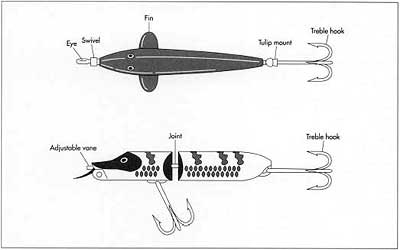
TO LURE MANKIND
By Bob Jamison
The vast fertile fields of Iowa corn and soy beans are known world wide. What most really doesn’t know is a blind testing laboratory built to take the guess work out of the manufacturing of fishing lures. It is known as Pure Fishing that was created in conjunction with the famous Berkley fishing tackle.
A common joke about the thousands of lures on the market in today’s Wal Mart, Academy, Bass Pro Shops, Cabelas and countless others is that ‘lures are made to catch fishing persons and not necessarily fish’. Another one I like is the clever individual that started to dispose of an old well used tooth brush.
However, before the tooth brush hit the trash can, this ardent fisherman with a fantastic imagination took the toothbrush to his shop. In the handle end he took a tiny drill and drilled a hole just smaller than the threads on a small ‘eye screw’. He put a drop of glue on the threads and seated the eye screw into the hole. On the brush end he repeated the process. Then he put a split-ring into the eye screw and attached a treble hook. He used the handle end eye screw to attach his fishing line.
The next experiment was to engage a lot of sea gulls diving into a swarm of bait fish or hopping shrimp. He would cast his “tooth brush lure” into the swarming bait action and retrieve it as he would a lure. It worked! Of course, all seasoned fishermen know that fish engaged in a feeding frenzy will hit almost anything including, but not limited to, a hickory nut with a hook and a buck-tail nailed to it.
Be that as it may, the Berkley Company takes a step or two beyond the tooth brush bait lure. By the way, that small step for mankind is, in fact, a giant leap in the fishing lure industry. No, it isn’t a mill pond with trained bass. It is a complete experiment station that compares lures they make and test their lures and lures of the competitor products for effectiveness, action, and even scents according to an article by John Merwin.
Merwin said they use a 36,000 gallon water tank in the configuration of circular travel lanes. Lure test are operated by precise robot pulling devices that drag the lure in the speed of a fishing reel. All lures are painted black (even though some fish are attracted to colors) and the hooks are bent to not allow the test fish to be hooked.
Cameras follow the reaction of five ten inch hatchery bass that have never seen a lure and have been fed only prepared fish food. These bass are rotated frequently to ensure that they will not become “trained” therefore completing the suggested blind testing of lures.
Adjustments are continually being made in laboratory that might change the attitude or vibrations of the lures to the end that fish will react positively to the lure. Also, water temperature variations are a further test to confirm differences in such fish reaction.
Most any person that has fished often with artificial lures would think twice about coating his hands with some types of insect repellent and then pick up a lure. He is without a clue as to the possibly of its repulsive taste or why it takes the paint off the lure. On the other hand, the Pure Fishing lab soaks little cotton balls with various scents to test the palatability to fish of their instinctive taste.
The result of the cotton test has brought to light such artificial (and sometimes dehydrated actual ingredient) products of Garlic, Crawfish, Thread Fin Shad, Minnows, Shrimp and others. They can be applied in the form of spray or even chum type pellets. And it seems logical that they will taste a lot better than insect repellant and maybe sunscreen.
Folks who fish seldom or often will find a very interesting comparison in choosing fishing lures. Some suggest that the first fish you catch that you should dissect the stomach of the fish. This way you can see what gourmet delight that particular fish has chosen for the bait du jour. Then tie on your choice lure that matches closest to the fish’s choice of food.
Other quite effective methods of catching fish are numerous. However, in public waters you might better check the regulations thoroughly before trying any of those old “tricks of the trade”; the friendly game warden could be watching.